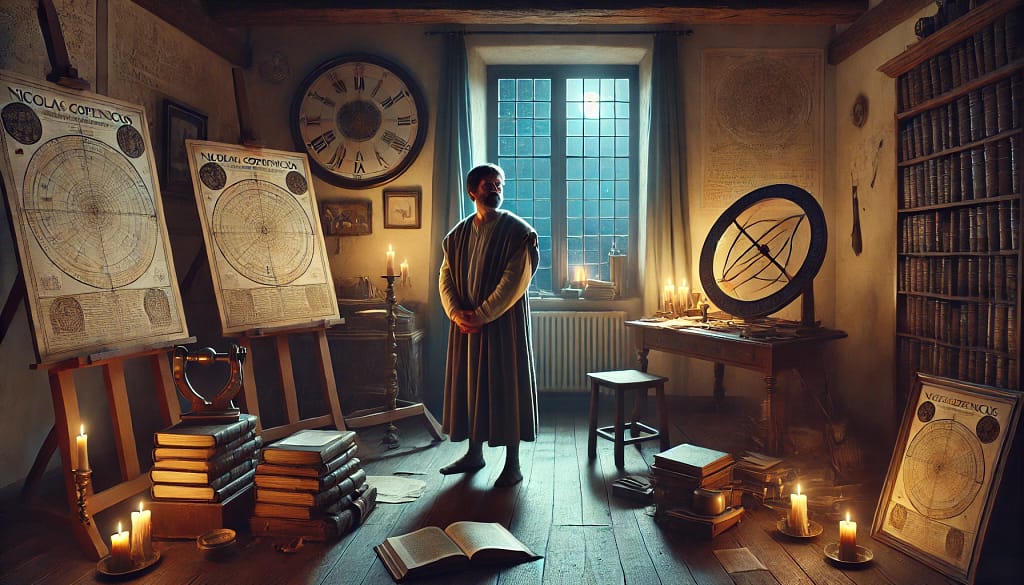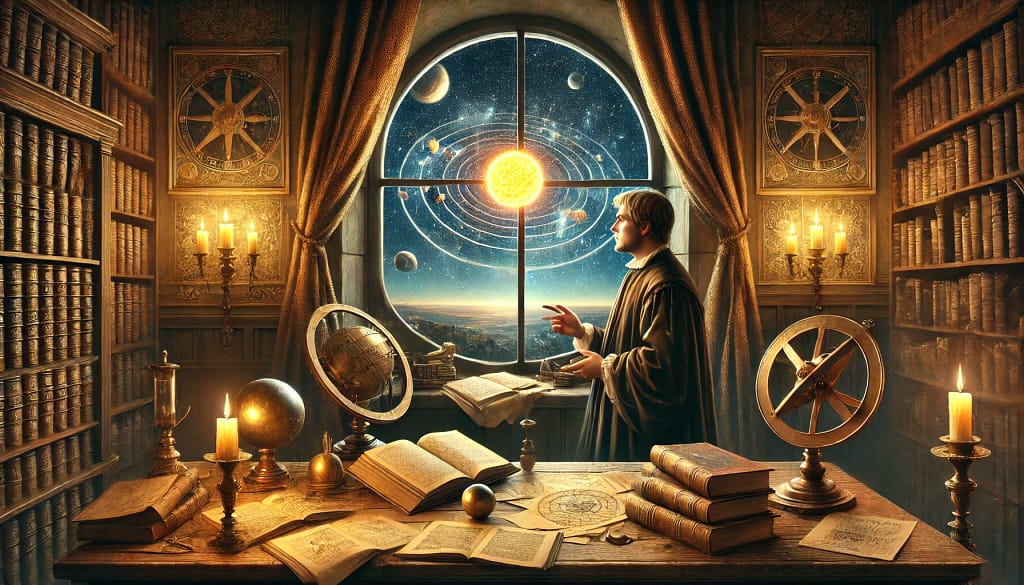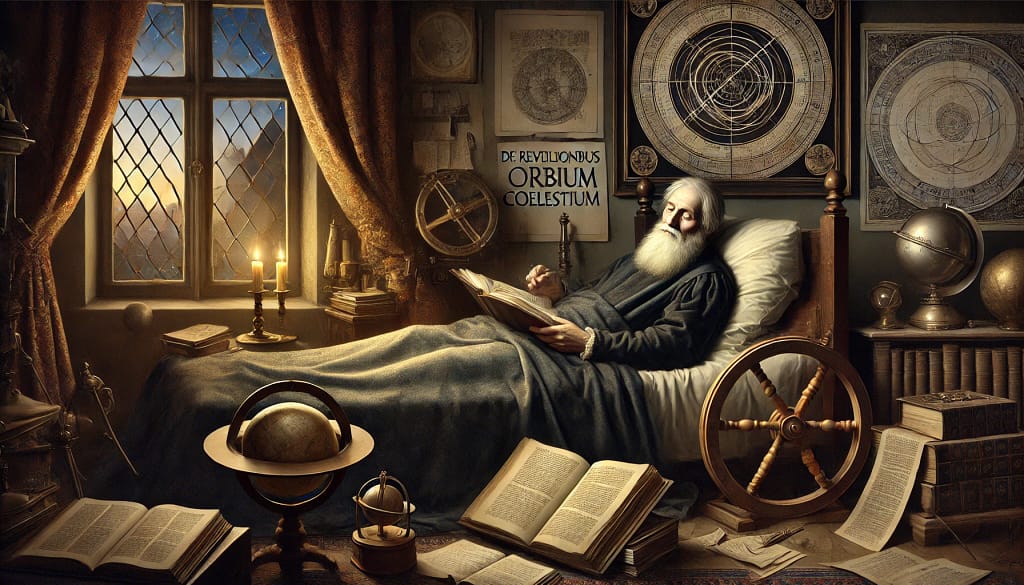In the quiet, unassuming town of Frombork on the northern edge of what is now Poland, a man of humble demeanor and profound intellect spent his days amidst dusty books and astronomical instruments. Nicolaus Copernicus, a canon of the Catholic Church, had long harbored a secret—a secret so daring that it would turn the world on its head.
For most of his life, Copernicus lived as a scholar, a man devoted to the quiet contemplation of the heavens. By day, he fulfilled his duties as a church official, but by night, his mind wandered among the stars. His modest quarters were filled with celestial charts and mathematical calculations, the fruits of his relentless pursuit to understand the true nature of the universe. Yet among these instruments of science, there was another influence—a book that had been rediscovered during the Renaissance, a text that whispered of a universe governed not by divine will, but by the natural order of things.

The Influence of an Ancient Text
This book was “De Rerum Natura” (On the Nature of Things), written by the Roman poet and philosopher Lucretius over a millennium earlier. In this ancient work, Copernicus found ideas that resonated with his own emerging thoughts. Lucretius, following the teachings of Epicurus, spoke of a universe composed of tiny, indestructible particles—atoms—that moved through the void according to natural laws. He rejected the idea that gods interfered in the workings of the cosmos, advocating instead for a rational understanding of the world based on observation and reason.
The materialist and naturalistic worldview presented in “On the Nature of Things” contributed to the intellectual climate of the Renaissance, a climate that was increasingly open to questioning long-held beliefs and seeking new explanations for the natural world. It was within this environment, shaped in part by the revival of classical texts like Lucretius’ work, that Copernicus’ own revolutionary ideas began to take form.
A Radical Idea
Copernicus, through years of careful observation and rigorous calculation, came to a startling conclusion. The movements of the planets, the retrograde motions, and the varying brightnesses all made more sense under a different model. What if, Copernicus mused, the Earth was not the center of the universe? What if it was the Sun that held that central place, with the Earth and other planets revolving around it?
This was the essence of Copernicus’ heliocentric theory: the Sun, not the Earth, was the true center of the cosmos. The Earth was just one of several planets that orbited the Sun, spinning on its axis to give the illusion of the heavens moving around us.

Years of Silence
Despite the brilliance of his theory, Copernicus hesitated to share his findings with the world. He knew that his ideas would be seen as heretical, a direct challenge to the Church’s teachings and the long-held beliefs of his contemporaries. For years, he kept his work hidden, discussing it only with a few close friends and fellow scholars who encouraged him to publish.
But Copernicus was not a man who sought fame or controversy. He continued to refine his ideas in private, quietly working on his manuscript, which he titled “De revolutionibus orbium coelestium” (On the Revolutions of the Celestial Spheres). It was a work of immense detail, laying out his heliocentric theory with precision and care.
All the while, the ideas he had absorbed from Lucretius’ ancient text—ideas about the natural order and the rejection of supernatural explanations—permeated his thinking. He knew that understanding the universe through natural laws, as Lucretius had advocated, could free mankind from the shackles of superstition and fear. But he also knew the risks involved in challenging the established order.
The Final Decision
As the years passed, Copernicus grew older, and his health began to decline. Despite completing much of his work by the early 1530s, the manuscript sat on his desk, untouched by the outside world. But his friends, particularly Georg Joachim Rheticus, a young mathematician who had come to study with him, urged him to publish it. They knew that this work could change the course of science forever.
Finally, in his last days, Copernicus relented. He allowed Rheticus to take the manuscript to be printed in Nuremberg, far from the prying eyes of the Church authorities in Rome. The printing process was long and laborious, and as Copernicus’ health worsened, it became a race against time.
The First Copy
It was a quiet day, May 24, 1543, when the first printed copy of “De revolutionibus” arrived in Frombork. Copernicus, now bedridden, was too weak to rise. His breath was shallow, and his vision blurred, but his mind remained sharp, aware of the gravity of the moment.
A trusted friend and colleague entered the room, holding in his hands the fruit of decades of Copernicus’ labor. Gently, he placed the book into the old scholar’s trembling hands. Copernicus opened the cover with great effort, his eyes scanning the first pages. The words he had written so many years ago, words that had lived only in his mind and on his fragile manuscripts, were now immortalized in print.
As he held the book close, Copernicus reflected on the journey that led him to this moment. The ancient ideas of Lucretius, rediscovered and revived in the Renaissance, had helped to inspire a new way of thinking—a way of understanding the universe through reason, observation, and natural laws, rather than through the dictates of tradition or divine intervention.
A faint smile crossed Copernicus’ lips as he realized that his life’s work, his daring vision of the cosmos, was now out in the world, free to challenge the minds of men and shake the foundations of established thought.

As the shadows of the evening grew longer, Nicolaus Copernicus slipped away, leaving behind a legacy that would forever alter humanity’s understanding of its place in the universe. “De revolutionibus orbium coelestium” was not just a book; it was the beginning of a new era, one where the Earth was no longer the center of all things, but just one small part of a vast, dynamic universe.
And so, with that first printed copy cradled in his hands, Nicolaus Copernicus departed this world, knowing that his ideas—nurtured by the wisdom of the ancients like Lucretius and guided by his own meticulous observations—would live on, sparking the flames of the Scientific Revolution and inspiring generations of astronomers, philosophers, and thinkers who would continue to explore the wonders of the cosmos.